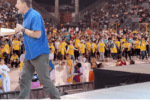NOW IS THE TIME TO TURN YOUR
HEALTH ASPIRATIONS INTO REALIZED GOALS. BUT BEFORE YOU GET STARTED, MAKE
SURE YOU UNDERSTAND THE FUNDAMENTALS WHEN IT COMES TO GETTING FIT.
Many
people think that as long as they work on their spiritual relationship
they are caring for God’s temple. But our physical bodies, our emotions
and our minds must be in good shape, too.
Besides owing it to
ourselves to strive toward a healthier life, we owe it to God. Having
good health will ensure that our time on Earth is more enjoyable and
effective for Him.
Getting
fit requires that you have some basic knowledge of how your body works.
If you are going to achieve your fitness goals, you must address all
three aspects of your health–cardiovascular capacity, muscle strength
and endurance, and flexibility.
Your cardiovascular capacity
is simply your ability to take in and process oxygen. The greater the
workload on your heart, the more efficient it becomes.
Muscle
strength is the ability to handle heavy loads quickly, while muscle
endurance is the ability to go the long haul. We need both.
Then
we must not forget flexibility. Your ability to stretch out your muscles
and allow your body to recover will determine how effective your
fitness and overall well-being will be in the future.
We need to
exercise in order to live a healthy life. The more you know, the better
equipped you will be to succeed in your program.
CARDIO EXERCISE THAT FITS
When
your heart is working at top performance, it is providing you with more
oxygen, which will give your muscles more strength and your energy
system a boost. The greater your capacity to process oxygen and use it,
the lower your blood pressure will be because the heart doesn’t have to
work as hard to get what it needs.
The heart needs workload
forced upon it to make it pump harder and push blood throughout the
body. Obtaining the health benefits you desire requires that you become
knowledgeable about cardio exercise so you can work out properly.
When
I train clients or speak to groups, I use the FITS formula to explain
the parameters of proper exercise. “FITS” stands for frequency,
intensity, time and style. We will explore these guidelines and how they
apply to each of the three aspects of fitness.
Frequency
Refers to how often you work out. According to Peg Jordan, in her book
Fitness: Theory & Practice, the Aerobics and Fitness Association of
America (AFAA) recommends that you engage in cardio exercise three to
five days a week.
If you’re working out only three days a week,
you probably won’t notice any serious changes to your outward
appearance. However, you should receive healthy benefits such as reduced
chances of heart disease and less illness.
The bottom line here
is to ensure you are exercising enough times throughout the week to help
your cardio ability (your heart) improve. I do a minimum of four cardio
days a week.
Intensity Has to do with how hard
you are working when you exercise. If you truly want to be healthy you
will need to work at an intensity level that makes doing anything else
impossible. Having an intensity level that is too low is probably one of
the biggest mistakes people make when working out.
You can
multitask–with little or no health benefits–or you can get serious,
put the magazine and cell phone away, and do it right. If you are going
to put in the time, make it count.
Time Refers
to how long you work out. New AFAA research indicates that we need at
least 30 minutes of continuous exercise for it to be effective for our
cardiovascular health. And in 2003, the AFAA published new data released
by the American Heart Association (AHA) that suggests we require a full
hour of cumulative exercise each day in order to receive health
benefits for the heart.
Everyday tasks such as walking, gardening
and sweeping are certainly good for the cumulative effect, but they
aren’t intense enough. You will need to ensure that you are balancing
both high-intensity exercise and other activities to keep you mobile.
Most
fitness classes are one hour in length to guarantee that you are
getting a solid 30 minutes of true cardio exercise. When you take into
account warm-up, cool-down and stretch, you are left with about 30 to 40
minutes of actual exercise.
Style Has to do
with how you exercise. The type of exercise you choose will have the
most influence on whether you stick to your program or not.
Personally,
I hate the treadmill. Put me outside, though, and I enjoy the challenge
of watching traffic, going up hills and actually going someplace. On a
treadmill, I hope to last 20 minutes. Outside, I can run 40 minutes or
more without giving it a second thought.
You have to find
something you enjoy. In my book Finally FIT! (Siloam), I offer advice
that will help you find the right style of exercise for your unique
temperament and personality.
RESISTANCE TRAINING THAT FITS
I
was never a big weightlifting fan until I learned why it was so very
important for me to incorporate it into my fitness program. You do it
not to be buff but to have strong bones.
Our bones are designed
for normal movement, but they need to grow stronger, more dense. This
happens only when they’re acted on by the muscles pulling on them.
Osteoporosis is a result of weak bones. If you do not have weight-bearing exercise in your life, your bones will be weak.
Calcium
is certainly necessary for our bone health, but density comes from
resistance training. When we add resistance to our muscles and make them
pull harder against the bones, the bones are forced to get thicker and
more dense.
Frequency. If you want a maintenance
program for healthy bones, doing resistance training one or two times a
week is plenty when combined with three to five cardio exercise days.
You should allow 48 hours between weight-training days.
Resistance
training breaks down the tissue in the muscle so that it can be made
stronger. To grow, muscle tissues need to be broken into more pieces
(multiplying) so that when they combine, you have more tissue than when
you started.
That’s why you get sore after you work out, but with
a proper cool-down and stretch, you shouldn’t truly hurt. If at any
time you begin to hurt, stop.
Intensity You
don’t have to lift hundreds of pounds to get the results you seek, but
you do need to lift properly. Ever see someone at the gym just belting
out his reps (repetitions) at warp speed?
If he slowed down his
reps and lifted properly, he would most likely need to decrease his
weights. His muscles would not be strong enough to handle the full load
since he’s been working only one phase of the muscle contraction
process.
As you lift, the muscle shortens. The “pull” enables you to lift the weight. You are moving against gravity, overcoming it.
But
it is typically the “release” of the lift when you have to be most
careful of not going too fast. Your muscle will want to let the weight
down quickly, but the slower you release it, the more you are working
the muscle.
Breathing out on the pull will give you power by
releasing oxygen into the muscle. It also slows you down and helps you
resist the temptation to pull up quickly. Breathing in on the release
provides oxygen to the required part of your body.
Time This is where reps come into play. A rep is the number of times you perform the exercise.
Your
fitness goal will determine the number of reps you complete. Those who
want to create healthy bones will use lighter weights and will benefit
from 12 reps, two times, which equals two “sets.” Someone who wants to
build muscle mass and develop muscle definition will lift heavier
weights for three sets of 10 reps each.
Style
Your temperament will greatly impact the style of weight resistance that
will work best for you. Free weights (handheld) are easy to use and can
be purchased and used at home. To use weight machines you’ll probably
need to join a gym.
However, free weights are more dangerous than
weight machines. Weight machines assist you in regulating the pressure
and force you to perform the exercise in a certain manner.
With
free weights you are required to use more of your core muscles to
stabilize yourself than on a machine. If your posture isn’t good when
you lift, you could hurt your back. If you use good form, then you are
building core muscle strength, and we all need more of that.
No
matter what type of resistance program you select, you need to ensure
that you are eating enough protein and drinking plenty of water.
Eliminate these, and you could damage your muscles.
STRETCHING THAT FITS
Stretching
is something we tend to forget in fitness programs, but it is paramount
to our overall health and well-being. Let’s take stretching through the
FITS formula.
Frequency Muscles require more
blood during exercise, so the body sends it to whichever muscles are
being recruited the most. You need your blood to be dispersed evenly
once you have finished to prevent blood clots.
Stretching is what
allows your muscles to perform at their best the next time you work
out. You should stretch before and after each cardio and muscle workout.
I also highly recommend that you add at least one day a week when you
stretch for 30 minutes solid.
Intensity Go slowly and work hard when you stretch. Be sure you breathe correctly.
Time You can stretch out in five to 10 minutes. Concentrate on stretching the muscles you know you will be using.
The
key to stretching is to “breathe through.” Take deep breaths and allow
the muscle to release and relax. Over time you will find your
flexibility increasing and your performance improving as a result of
stretching.
Style Of the different types of stretching, I recommend rhythmic limbering and static stretching.
Rhythmic
limbering is warming up the muscles you expect to utilize in a workout.
You are performing the exact movements but with less intensity.
For
example: Before an aerobics class, your warm-up should include
limbering and static stretches, especially if you are to perform
high-power moves such as kickboxing. You should cool-down with limbering
moves until the heart rate declines slightly. Then static stretch the
lower and upper body as well as the back.
A static stretch is
done by holding a position for a few seconds and breathing through. For
instance, with a quad stretch, you stand, holding your foot so that your
leg is curled behind you. Without bouncing or moving, you stretch the
quad muscles out by holding the position for a few seconds and
breathing.
Exercise, especially resistance training, makes the
muscles tight. Without stretching, over time you will lose flexibility,
leaving you susceptible to injury.
Stretching is preventive maintenance. The more mobile you are, the less likely you are to pull a muscle.
In
order to live a healthy life, you must include all three pillars of
fitness–cardiovascular capacity, muscle strength and endurance, and
flexibility–in your weekly regimen. These fundamentals are much more
complex than I have indicated, but now you have a good base and can
begin customizing a program that works with your goals, personality type
and temperament.
Now let’s get started! You’re on your way to a more active lifestyle and a healthier you.
Lorraine Bossé-Smith is the author of Finally FIT! (Siloam), from which this article is adapted.






Leave a Comment
You must be logged in to post a comment.